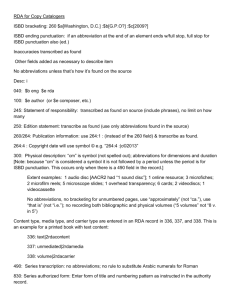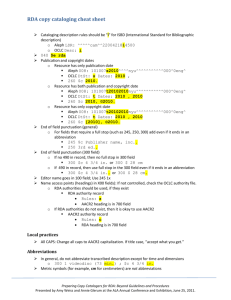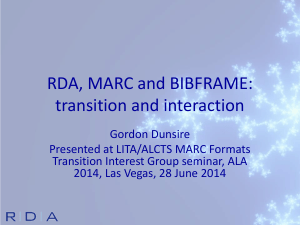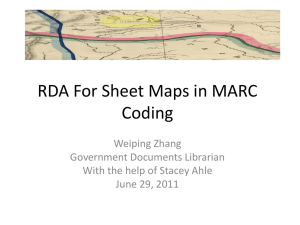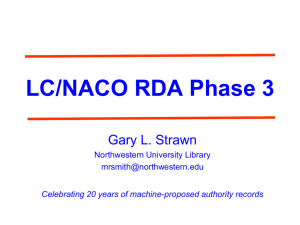draft - Joint Steering Committee for Development of RDA
advertisement
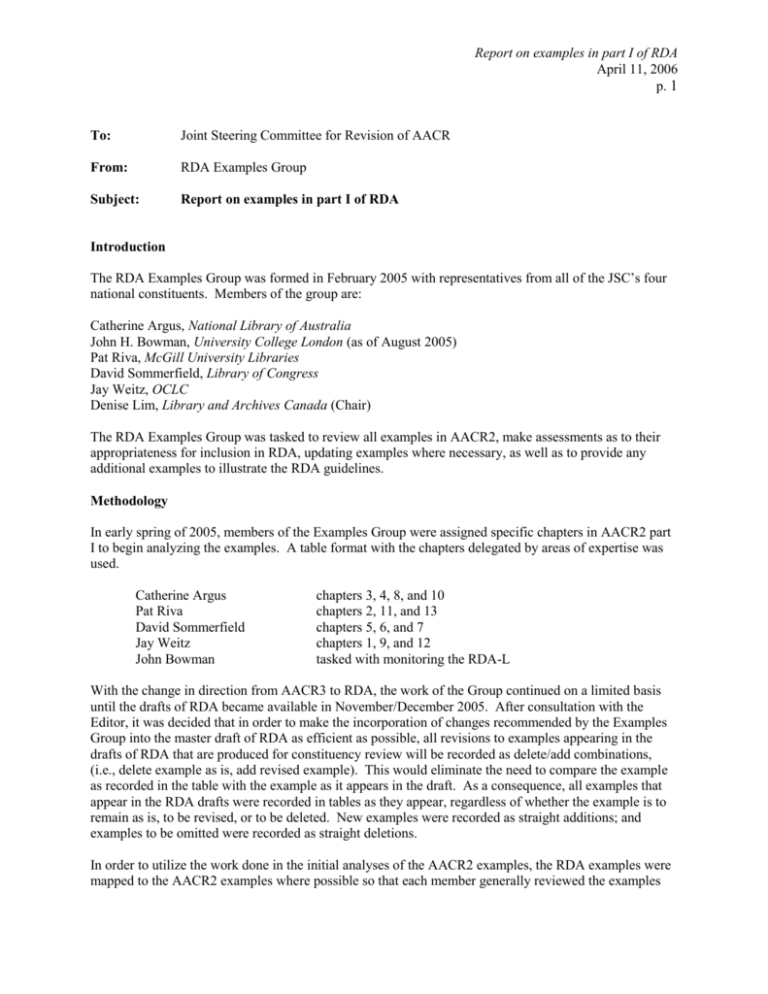
Report on examples in part I of RDA April 11, 2006 p. 1 To: Joint Steering Committee for Revision of AACR From: RDA Examples Group Subject: Report on examples in part I of RDA Introduction The RDA Examples Group was formed in February 2005 with representatives from all of the JSC’s four national constituents. Members of the group are: Catherine Argus, National Library of Australia John H. Bowman, University College London (as of August 2005) Pat Riva, McGill University Libraries David Sommerfield, Library of Congress Jay Weitz, OCLC Denise Lim, Library and Archives Canada (Chair) The RDA Examples Group was tasked to review all examples in AACR2, make assessments as to their appropriateness for inclusion in RDA, updating examples where necessary, as well as to provide any additional examples to illustrate the RDA guidelines. Methodology In early spring of 2005, members of the Examples Group were assigned specific chapters in AACR2 part I to begin analyzing the examples. A table format with the chapters delegated by areas of expertise was used. Catherine Argus Pat Riva David Sommerfield Jay Weitz John Bowman chapters 3, 4, 8, and 10 chapters 2, 11, and 13 chapters 5, 6, and 7 chapters 1, 9, and 12 tasked with monitoring the RDA-L With the change in direction from AACR3 to RDA, the work of the Group continued on a limited basis until the drafts of RDA became available in November/December 2005. After consultation with the Editor, it was decided that in order to make the incorporation of changes recommended by the Examples Group into the master draft of RDA as efficient as possible, all revisions to examples appearing in the drafts of RDA that are produced for constituency review will be recorded as delete/add combinations, (i.e., delete example as is, add revised example). This would eliminate the need to compare the example as recorded in the table with the example as it appears in the draft. As a consequence, all examples that appear in the RDA drafts were recorded in tables as they appear, regardless of whether the example is to remain as is, to be revised, or to be deleted. New examples were recorded as straight additions; and examples to be omitted were recorded as straight deletions. In order to utilize the work done in the initial analyses of the AACR2 examples, the RDA examples were mapped to the AACR2 examples where possible so that each member generally reviewed the examples Report on examples in part I of RDA April 11, 2006 p. 2 from his/her assigned AACR2 chapters. A table format was used to copy each example in RDA following the Editor’s suggestion. The change in presentation of the examples to data element only and, in most cases without ISBD punctuation, required re-examination of the AACR2 examples for reconfiguration or modification, e.g., addition of explanatory text. In some instances, new examples, more up-to-date examples, or other AACR2 examples deemed to be appropriate were added for inclusion into RDA. Examples that were “re-used” at different guidelines were generally replaced by new ones to reduce the repetition. Following terms suggested by the Editor, the Group also categorized where possible the examples by type of resource and mode of issuance to be used as the basis for providing customized or user-selected views of RDA part I. Status All RDA examples have been reviewed and formatted into tables as outlined above. Tables of the examples suitable for incorporation into the master text of RDA form the major part of this report. Some examples, however, will need to be reviewed pending JSC decision on some outstanding issues. Examples in the tables for chapter 3 are still in the “raw data” stage as chapter 3 has only undergone the initial review and the consolidation has yet to be analyzed. The Group feels that JSC decisions based on the findings of the GMD/SMD Working Group would have a major impact on chapter 3 and recognizes that chapter 3 is even more of a moving target than the other five chapters and would therefore require a more thorough re-examination after the April JSC meeting. Information in the Type of Resource and the Mode of issuance columns are at best preliminary. The Group still needs to ensure that there is consistent application of the terms that have been suggested for use by the Editor. The Editor noted that final instructions on what is to be included in the concise were needed before the criteria for inclusion of examples could be determined. Therefore, the indicator in the column identified C* is not reliable at this stage. Examples will need to be reviewed pending JSC consideration of issues noted below and in light of comments made at the April JSC meeting. Appendix D has not been reviewed. The following documents with comments related to examples have been distributed to the Group but comments have not yet been followed up: 5JSC/RDA/Part I/Chair follow-up /1, 2, and 4 - Comments from international community (France, Germany, Sweden) 5JSC/ALA/2 - Rule revision proposals relating to technical description of digital media 5JSC/RDA/Part /CILIP response - Comments related to the examples. Issuing other examples in a separate document has not been thoroughly investigated. Issues considered by the Group 1. Consideration of the number of examples per instruction and of having a separate document for examples The Group feels that no fixed number of examples could be applied and that the number depended on the instruction itself. Some require more, e.g., when the text covers multiple types of resources or if examples in various formats or different modes of issuing are appropriate. Report on examples in part I of RDA April 11, 2006 p. 3 2. 3. 4. 5. 6. 7. On the issue of a separate document of examples, the Group feels that this would only be useful if the instructions could be incorporated in the document or if the online version can provide transparent (multi-) links between the segregated examples and the text. Consideration of examples to be included as full examples in appendix D and whether these examples are to be identified in the text At present, no examples have been identified as candidates for appendix D. It would be helpful, however, to include examples from the text in appendix D to illustrate how data elements for a single ISBD area fit together. Some areas will particularly benefit from at least full area examples, such as publication, or title area with parallel information, or no collective title, and the more complex edition statements. Consideration of the use or non-use of terminal punctuation in notes (2.4.3.9) versus fields that generate both an access point and a note (2.3.5.4) There appears to be no advantage for access in enforcing the difference between plain notes and dual-use notes, particularly as other dual-use fields may end in terminal punctuation, e.g., a title proper with no statement of responsibility. The Group recommends that no terminal punctuation be used in all cases. Consideration of consistency of inclusion of examples in situations when a reference is made to another instruction, e.g., 2.3.5.6b, option, to see 2.3.8.4, should the type of example that is to be found at 2.3.8.4 also be given as an example at 2.3.5.6b, option? (Another example at 2.3.1.11 and 2.3.5.4b) The Group is not conclusive on this issue. Judging this on a case by case fashion is one possibility although there is concern that there might be some danger in following the example instead of consulting the relevant instruction. In some cases, the example is just repeated and this was not considered favourable. In general, examples do illustrate the instructions and use of examples are helpful, especially ones with transcription difficulties. Principles of inclusion of an example; whether an example should just illustrate the instruction generally or whether unusual examples should also be given with explanatory notes, e.g., examples proposed for 2.12.1.4 (Table 2bb) The feeling on this issue is not conclusive. One suggestion is to have unusual examples appear in a separate document or, in the online version, for the user to see a link such as “more examples”. The feeling is that the more unusual cases are useful to the experienced cataloguer and that suggested examples for inclusion from the Group indicate that they are of value. Use of non-user friendly terms in the descriptive notes (e.g., parallel title, subtitle, other title information) Parenthetical explanations about examples should use the specific technical cataloguing terminology. The text of a public note, however, does need to be intelligible to end users. In that sense a note like: Title in French is more geared to the end-user while a note like: Parallel title is more geared to fellow cataloguers. What needs to be determined is which terms, while specialized, are used sufficiently like their dictionary meaning, and which ones are library jargon, e.g., subtitle is in pocket Oxford whereas parallel title is not. Reaction to the many comments about the form of the examples, i.e., by element without the use of ISBD punctuation in most cases, whether the presentation of the examples can be improved and whether the explanatory texts are sufficient The Group suggests a greater use of ISBD in examples where relationship is a concern (e.g., parallel titles with corresponding statements of responsibilities, relationship between numeric designations and chronological designations in numbering). Full area Report on examples in part I of RDA April 11, 2006 p. 4 examples in appendix D will also help. On the other hand, this issue could just be a matter of users becoming familiar with the new “look”. 8. Incorporation of more (or is there enough?) examples in languages other than English in RDA Some French, Italian, German, etc., examples have been added in titles, series, editions and other textual transcription fields. This does help “internationalize” the text and libraries do catalogue material in many languages. However, if cataloguers cannot understand how the example relates to the instruction, then the example is not helpful. Non-roman script examples and right-to-left examples have not been added. 9. Examples are definitely not prescriptive but how should this be illustrated? Will giving different forms of examples appear as inconsistencies or will they illustrate that “anything goes” (e.g., title from caption, caption title)? One suggestion is to use a strategically placed or for alternative wording when the intention is not to be prescriptive. Even though examples are not the instruction, they are consulted as an example of “good style”. Observations The timeframe for this activity was difficult. Deadlines were set for the review of each chapter but not all reviews were received within the timeline which was too tight given the amount of work that needed to be done, especially to the level of detail required for each example, e.g., validity, form, clarity, conciseness. Additionally, this exercise proved particularly complex since there was no common table into which all could submit their comments. Each Group member’s comments had to be consolidated into a composite that was then sent back to the Group for further comments. Because timelines for initial reviews were not always met, consolidations of the initial round of reviews were not consistently reviewed by the entire Group to determine overlap, etc. Consolidations of reviews could have gone several rounds but as a consequence of the timeline, some decisions had to be undertaken by the Chair. Some issues regarding the wording of instructions that have an effect on examples could not be resolved by the Group. Within the timeframe allotted suitable examples could not be identified in all cases. Of concern is the lack of more current examples for electronic resources (former AACR2 chapter 9). The next review of RDA part I should identify and clarify where further examples are needed in the context of the revised draft. General issues for JSC consideration What is JSC’s opinion on being less prescriptive? Should there be consistency in the form of notes or should different forms of notes be given to indicate that there is no right form or will this be interpreted as inconsistencies in the example? What about the use of abbreviations? Should spelled out forms as well as abbreviations be used? What is JSC’s opinion on whether there should be consistency as to whether examples should be given to illustrate the see reference (e.g., 2.3.3.3, final paragraph, examples illustrate the see reference 2.11 where the example would be given as well)? Should there be more foreign language examples, examples reading from right to left? Report on examples in part I of RDA April 11, 2006 p. 5 Since appendix B (abbreviations) is not yet available, should the examples include abbreviations for terms such as t.p., facsim., ms., ca.? Presentation of examples: CILIP’s suggestion of having different presentational interfaces, labelled OPAC presentation, ISBD presentation or even MARC presentation sounds like a good idea. However, to present the examples in these formats may be beyond the scope of this Group which has been focusing on content. For instance, in the case of an example following ISBD presentation, just adding the preceding punctuation may not be sufficient. The whole example may have to be reconstructed and evaluated in the context of the structure of RDA. As outlined above, the work on the examples for part I is a continuous process. In my capacity as chair of the Examples Working Group, I do not feel that it will be feasible for me to play a similar role for parts II and III.


